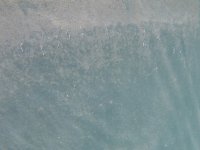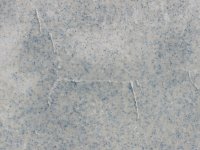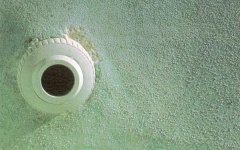Calcium Nodules
In 1998, the onBalance team published a paper in the Journal of the Swimming Pool and Spa Industry (JSPSI) on calcium nodule formation. The paper provided the science and mechanics for the cause of calcium carbonate nodules developing in pools. It explained that delaminated plaster (bond failure) spots/areas can cause cracks to develop over time and result in nodules continually growing on the visible cracks. It also explained that LSI (or CSI) aggressive water does not cause calcium nodules to grow on delaminated cracks. In 2019, some leaders of the pool plastering industry acknowledged that fact.
An Unusual Type of Nodule Formation
About a dozen years ago, the onBalance team began investigating a slightly different and smaller type of nodule in recently plastered pools. Some of the nodules had not developed on delamination cracks, but instead, they had formed on severe “crazing” or “check” cracks that were nearly invisible. See photos of small nodules:


A few pools were drained, and core samples of the small nodules were sent to a professional cement lab for petrographic examination. The labs verified that crystalline calcium nodules had formed on excessive shrinkage cracks and not a delamination cracks. It concluded that if cracks are large enough, small nodules can grow on the almost invisible cracks. The lab confirmed that the formation of the small nodules have the same mechanics and reactions that cause large delamination nodules. Also, the cement lab ruled out aggressive water because there was no sign of any (aggressive water) etching of the plaster surface.
Nodules Are Different From Scale
Calcium “nodule” formation is different from the common and uniform calcium scale that forms on pool surfaces as to due to very hard and out-of-balance pool water. This article is about the random formation of crystalline and sharp calcium carbonate nodules that continually grow on small cracks and protrude above the surrounding smooth plaster surface. See Photo of scale:

Cement/Plaster Science
It has been documented by the ACI and PCA that abnormal and severe check cracking or crazing can develop in cement/plaster surfaces for several distinct reasons. Hot dry weather, or strong winds can dry the cement/plaster surface and cause excessive shrinkage cracks. Also, poor workmanship and materials, such as adding a high content of water and calcium chloride to the (cement/plaster) mix can cause excess shrinkage and result in severe craze cracking of the cement/plaster surface. Proper mixing and proper application minimize shrinkage problems.
A False Theory
Unfortunately, there are some plaster people that are still trying to convince pool owners and service techs that (LSI) aggressive pool water causes the nodules to form on micro-cracks which are present in normal plaster. That is nonsensical; aggressive water dissolves calcium carbonate and prevents the formation of nodules, including common scale. And pool water chemistry plays no part in causing plaster shrinkage and cracking.
Their Own Test Pool Experiments Provided Contrary Evidence
It is interesting to note that those who suggest that aggressive water causes nodules likely know that the joint NPC, NPIRC, and Cal Poly Test Pool project (2004-2008) provided the pool industry with strong evidence that nodules are not caused by LSI (or CSI) aggressive water.
For example, during the four years of experiments, many test pools were plastered by the NPC and maintained with LSI aggressive water for 8 months at a time. Some test pools even had an acid startup performed. The pools were then drained and inspected by many pool industry people. There were no reports of calcium nodules in the test pools. If aggressive water causes nodules to form, then nodules should have formed in those pools.
Other evidence is that cement sidewalks do not form nodules on cracks when subjected to rain which is very aggressive by pool water chemistry standards.
This plaster nodule problem should not be controversial. Those who maintain the pool water chemistry should not be blamed for causing this plaster problem. And unfortunately, there are other plaster defects that are being (incorrectly) blamed on aggressive water chemistry also. This nonsense needs to end.
For a more complete and detailed explanation of all types of calcium nodule formation, click this link: Calcium Nodules – Pool Help
To review the petrographic studies by the professional cement lab on calcium nodules, click this link: https://2e7fc7.p3cdn1.secureserver.net/wp-content/uploads/2023/03/JSPS_V6N2_pp20-26b.pdf
In 1998, the onBalance team published a paper in the Journal of the Swimming Pool and Spa Industry (JSPSI) on calcium nodule formation. The paper provided the science and mechanics for the cause of calcium carbonate nodules developing in pools. It explained that delaminated plaster (bond failure) spots/areas can cause cracks to develop over time and result in nodules continually growing on the visible cracks. It also explained that LSI (or CSI) aggressive water does not cause calcium nodules to grow on delaminated cracks. In 2019, some leaders of the pool plastering industry acknowledged that fact.
An Unusual Type of Nodule Formation
About a dozen years ago, the onBalance team began investigating a slightly different and smaller type of nodule in recently plastered pools. Some of the nodules had not developed on delamination cracks, but instead, they had formed on severe “crazing” or “check” cracks that were nearly invisible. See photos of small nodules:


A few pools were drained, and core samples of the small nodules were sent to a professional cement lab for petrographic examination. The labs verified that crystalline calcium nodules had formed on excessive shrinkage cracks and not a delamination cracks. It concluded that if cracks are large enough, small nodules can grow on the almost invisible cracks. The lab confirmed that the formation of the small nodules have the same mechanics and reactions that cause large delamination nodules. Also, the cement lab ruled out aggressive water because there was no sign of any (aggressive water) etching of the plaster surface.
Nodules Are Different From Scale
Calcium “nodule” formation is different from the common and uniform calcium scale that forms on pool surfaces as to due to very hard and out-of-balance pool water. This article is about the random formation of crystalline and sharp calcium carbonate nodules that continually grow on small cracks and protrude above the surrounding smooth plaster surface. See Photo of scale:

Cement/Plaster Science
It has been documented by the ACI and PCA that abnormal and severe check cracking or crazing can develop in cement/plaster surfaces for several distinct reasons. Hot dry weather, or strong winds can dry the cement/plaster surface and cause excessive shrinkage cracks. Also, poor workmanship and materials, such as adding a high content of water and calcium chloride to the (cement/plaster) mix can cause excess shrinkage and result in severe craze cracking of the cement/plaster surface. Proper mixing and proper application minimize shrinkage problems.
A False Theory
Unfortunately, there are some plaster people that are still trying to convince pool owners and service techs that (LSI) aggressive pool water causes the nodules to form on micro-cracks which are present in normal plaster. That is nonsensical; aggressive water dissolves calcium carbonate and prevents the formation of nodules, including common scale. And pool water chemistry plays no part in causing plaster shrinkage and cracking.
Their Own Test Pool Experiments Provided Contrary Evidence
It is interesting to note that those who suggest that aggressive water causes nodules likely know that the joint NPC, NPIRC, and Cal Poly Test Pool project (2004-2008) provided the pool industry with strong evidence that nodules are not caused by LSI (or CSI) aggressive water.
For example, during the four years of experiments, many test pools were plastered by the NPC and maintained with LSI aggressive water for 8 months at a time. Some test pools even had an acid startup performed. The pools were then drained and inspected by many pool industry people. There were no reports of calcium nodules in the test pools. If aggressive water causes nodules to form, then nodules should have formed in those pools.
Other evidence is that cement sidewalks do not form nodules on cracks when subjected to rain which is very aggressive by pool water chemistry standards.
This plaster nodule problem should not be controversial. Those who maintain the pool water chemistry should not be blamed for causing this plaster problem. And unfortunately, there are other plaster defects that are being (incorrectly) blamed on aggressive water chemistry also. This nonsense needs to end.
For a more complete and detailed explanation of all types of calcium nodule formation, click this link: Calcium Nodules – Pool Help
To review the petrographic studies by the professional cement lab on calcium nodules, click this link: https://2e7fc7.p3cdn1.secureserver.net/wp-content/uploads/2023/03/JSPS_V6N2_pp20-26b.pdf

